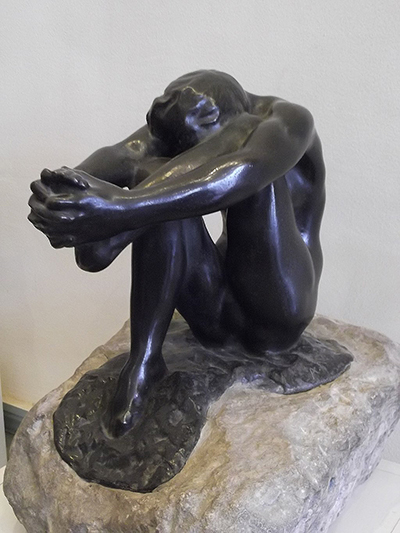Despair, also known as Despair at the Gate, was developed over a number of years by French sculptor, Auguste Rodin. It was initially started in the early 1880s which was a time of great experimentation for the artist.
This piece would be used within the Gates of Hell ensemble which took years of work to accomplish. It would become the artist’s most famous contribution, alongside The Kiss and The Burghers of Calais. Even today it forms a key element in the studies of the history of sculpture, even when considering this art form from a global perspective. The original inspiration would be the nine circles of Hell as mentioned by Dante in the world famous Divine Comedy, where a group of damned souls were to be found. Despair therefore is intended to represent one of those figures on the front of the gate design. There would be multiple versions of this design across different materials, including plaster, bronze and marble which was the case for many of his favourite designs, right across his career.
The pose is similar to what you might expect to find within a Degas ballet dance scene, and Rodin loved to challenge his models to pull off some unusual and perhaps unnatural postures. In this case she stretches out her hands to grab hold of her own left foot, which is perched just across her right leg. Her head is sunken into her chest and legs, giving the impression of despair, or Le Désespoir, as used in the title of the piece. It could almost be a three dimensional version of one of Munch's last Expressionist artworks such as The Scream, Despair or Anxiety. Rodin himself loved to centre in on the human body and attempted to capture it as perfectly as he possibly could. Whilst building his early reputation some critics even questioned his techniques because they could not believe that he could work so precisely using the methods that he was. It was only later that they became aware of his genius and stopped making such hurtful allegations.
Whilst working from inspiration of literature, the precise pose found within Despair has nothing in common with anything that he had read, and more likely would have been a moment of creativity whilst working with his models. Most likely it was his suggestion, as he demanded much from his models, but it may alternatively have occurred completely naturally as they changed position. Indeed he would not name the piece as Despair until around the year 1900, according to the documentation that we have, and therefore he did not intend the melancholy look at the time, but it just seemed appropriate upon reflection later on. The way in which the head is drooped down makes it feel like this was intended right from the off, making it a good subsequent choice.




